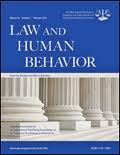
Self-reported within-treatment change in antisocial attitudes may not provide valid information about change in offenders’ risk of reoffending as a result of completing treatment. This is the bottom line of a recently published article in Law and Human Behavior. Below is a summary of the research and findings as well as a translation of this research into practice.
Featured Article | Law and Human Behavior | 2018, Vol. 42, No. 4, 321-335
Within-Treatment Change in Antisocial Attitudes and Reoffending in a Large Sample of Custodial and Community Offenders
Author
Mark V. A. Howard, Corrective Services New South Wales, Australia
Gerard van Doorn, Corrective Services New South Wales, Australia
Abstract
This study tested evidence for antisocial attitudes as a mechanism of change in offender treatment by examining whether the Measures of Antisocial Attitudes and Associates (MCAA) and within-treatment change in scores on this scale have predictive validity for risk of reoffending. Pretreatment and posttreatment scores on the MCAA were obtained from a large sample of 1,858 offenders who had completed offender treatment programs while in custody (n = 854) or in the community (n = 1,004). Individual within-treatment change was calculated with simple difference scores as well as categorizations of clinically significant change. Results showed that discrete scores on a number of MCAA measures were associated with reoffending hazard at pretreatment and at posttreatment. Change over treatment was also highly significant at the group level whereas a modest proportion of offenders achieved clinically significant change. None of the measures of within-treatment change were significantly associated with reoffending, however. The results suggest that self-reported antisocial attitudes may not be a valid indicator of causal mechanisms of treatment or change in offenders’ risk of reoffending as a result of completing treatment.
Keywords
antisocial attitudes, recidivism, within-treatment change, mechanism of change, clinical significance
Summary of the Research
“In recent years a substantial body of research has developed to support the effectiveness of offender treatment in reducing reoffending. Meta-analytic reviews have also indicated that offender treatment is increasingly effective when it adheres to principles of the RNR [risk-need-responsivity] model. However, there has been surprisingly little empirical study to examine how treatment reduces reoffending, or more specifically to validate the role of dynamic risk factors as mechanisms of change in accordance with the need principle. To understand the causal effect of within-treatment change in dynamic risk factors, it is necessary to establish that the factor has a predictive relationship with reoffending; that treatment induces change in the factor; and that there is an association between factor-specific change in treatment and reoffending outcomes” (p. 321-322).
“There is an identified need for further research to assess mechanisms of change within offender treatment programs. Understanding the relationships between change in dynamic risk factors and reoffending outcomes is critical to identify the content and processes of interventions and how targets may be prioritized in the development and delivery of programs. It is also important to better understand processes of individual within-treatment change because not all offenders will require treatment for specific risk factors and not all offenders will achieve change as a result of treatment, which has implications both for identification of target samples and interpretation of treatment outcome evaluations. Research into treatment effects of offender programs typically evaluates average group-level differences relative to controls and, therefore, tends to be insensitive to intraindividual dynamics. In addition, while some studies have examined the predictive validity and within-treatment change on the [Measures of Criminal Attitudes and Associates] MCAA, further research is required to integrate and improve the statistical rigor of analyses relevant to mechanisms of change” (p. 323).
“The aim of this study was to examine relationships between self-reported antisocial attitudes, individual change in attitudes over the course of treatment, and reoffending outcomes. To achieve this we developed a large and diverse sample of offenders who had completed pretreatment and posttreatment administrations of the MCAA as part of their participation in treatment while serving sentences in custody or in the community. This study sought to address three conditions that have been identified as necessary for a putative mechanism of change, including: (a) discrete scores on the MCAA have temporally relevant relationships with reoffending outcomes; (b) scores on the MCAA change over the course of treatment; and (c) change in scores over treatment correspond with differences in reoffending outcomes” (p. 323).
“A secondary aim of the study was to examine patterns of responses on the MCAA and their associations with reoffending separately for offenders who completed self-reports of antisocial attitudes when in custody and those who were assessed in the community. Offenders in the community have closer temporal and contextual proximity to risk factors at the time of treatment that may influence the extent to which their reported antisocial attitudes and change in attitudes transfer to reoffending outcomes. This difference may partially account for findings that treatment in the community tends to have larger effect sizes compared with treatment in custody. On the balance of the existing literature we hypothesized that associations between MCAA scores and reoffending, and between within-treatment change and reoffending, would be more pronounced when assessed for offenders in the community compared with offenders in custody” (p. 323).
“The results of this study showed that measures of antisocial attitudes derived from the MCAA meet a number of conditions for being mechanisms of change in offender treatment, including predictive validity for reoffending outcomes and evidence for significant change over the course of treatment. Within-treatment change in MCAA scores did not correspond with change in risk of reoffending, however. This pattern of results indicates that while discrete scores on the MCAA can contribute to an understanding of an offender’s risk of reoffending and case management needs, change in scores over treatment are not a reliable indicator of how the offender’s risk has been influenced by participation in treatment. We do not propose to conclude that change in antisocial attitudes is not a meaningful target for offender interventions or causal factor in the relationship between treatment and reoffending. However, the findings add to those of other research on offense supportive attitudes in highlighting the ongoing empirical challenges with measuring and identifying such dynamic risk factors as mechanisms of change. Further research into factors that influence offender responding over the course of treatment and potential change to methods of assessing offenders is required. At present, and in regards to the MCAA, it appears that the search for the ‘Holy Grail in assessing offender change’ continues” (p. 331-332).
Translating Research into Practice
“The results of within-treatment change analyses were disappointing, particularly considering that in contrast to some previous studies of offender change, discrete scores on the MCAA were found to have predictive validity for reoffending in our sample. Taken together, it appears that the MCAA did not meet this critical condition for a mechanism of change because the magnitude or nature of change over the course of treatment did not have a meaningful relationship with reoffending. One interpretation of the results is that change in MCAA scores reflects actual offender change in dynamic risk factors associated with antisocial attitudes; however, these factors do not ultimately have an effect on likelihood of reoffending. The outcome of recidivism is one of multiple determinants and change in antisocial attitudes may be necessary but not sufficient for a reduction in risk to occur. For example, treatment may act to simply reduce antisocial attitudes without developing compensatory prosocial attitudes that facilitate desistance over time. Similarly, discussed the potential that antisocial attitudes act as a proxy for other individual propensities that affect the likelihood of antisocial behavior under conditions of risk. A related interpretation is that change in antisocial attitudes contributes too small an effect size to influence outcomes, particularly given the insensitivity of formal measures of reoffending. However, in this case it is uncertain why discrete measures of antisocial attitudes would be independently predictive of reoffending. It is also noted that the EQUIPS programs contain multiple modules that address a range of general and offense-specific risk factors that include but are not
limited to antisocial attitudes” (p. 330).
“Perhaps a more parsimonious explanation of the results is that change in MCAA scores between pretreatment and posttreatment may be attributed to measurement factors that are not related to underlying attitude change. In particular, different contextual and temporal influences between pretreatment and posttreatment may affect reporting of antisocial attitudes. Declines in antisocial attitudes following completion of treatment may represent transient effects of treatment or temporarily activated sentiments that do not persist over time. A study by Polaschek and Dixon (2001) showed that while both recidivists and nonrecidivists reported significant reductions in anger over the course of treatment, only nonrecidivists continued to report those changes at follow-up whereas recidivists showed a regression in scores. In addition, completion of treatment is likely to be associated with demand effects that incentivize prosocial responding, such as efforts to demonstrate successful outcomes of treatment or the development of a working alliance with therapists, which are not present before treatment. Offenders are often motivated to participate in treatment for external gains such as receiving parole that may be contingent on evidence of positive treatment progress” (p. 330).
Other Interesting Tidbits for Researchers and Clinicians
“There is the possibility that offenders in the community have different contextual influences on their responding and likelihood of response bias compared with those in custody. However, an examination of the data suggests that the results may be most likely attributed to differences in sample characteristics. Offenders in custody had a wider distribution of MCAA scores and were more likely to reoffend compared with those in the community, which would be expected to influence the power of measures of association. Offenders in custody also reported more dysfunctional antisocial attitudes on average compared with those in the community. There are indications that reoffending risk and related dynamic risk factors such as antisocial attitudes have a negative association with social desirability bias and impression management response bias in particular. This suggests that as offender risk increases the relationship between responses and underlying latent constructs may be less prone to these sources of measurement error. The results emphasize the importance of sampling factors, including selection of offenders according to the extent and homogeneity of criminogenic need, when assessing the psychometric properties of measures of dynamic risk factors. It is noted that whereas the only previous study of within-treatment change on the MCAA was conducted with offenders in the community, available data to support the predictive validity of the MCAA for reoffending have been derived from custodial samples. Conversely, the results suggest that proximity factors such as time in custody between assessment and release may have had only limited influence on the predictive utility of the MCAA” (p. 329).
“There is evidence to suggest that offender self-reports of antisocial attitudes can convey information about risk of reoffending that is robust to response biases, including but not limited to findings for the predictive validity of MCAA measures reported here. However, it is less clear how the context of assessment has an influence on the nature or extent of responding bias. The influence of context specific socially desirable responding may explain findings that discrete posttreatment scores on self-report measures have weaker relationships with reoffending compared to pretreatment scores. The relative contributions of trait-like response tendencies and contextual demands to socially desirability bias is a subject of ongoing discussion, with evidence for the role of both factors. We are currently conducting research to explore how changing context affects offenders’ self-reported antisocial attitudes over multiple administrations across consecutive treatment programs. Further study is also required to better understand and implement procedures under which within-treatment change can be best assessed to minimize response bias” (p. 330-331).
Join the Discussion
As always, please join the discussion below if you have thoughts or comments to add!















